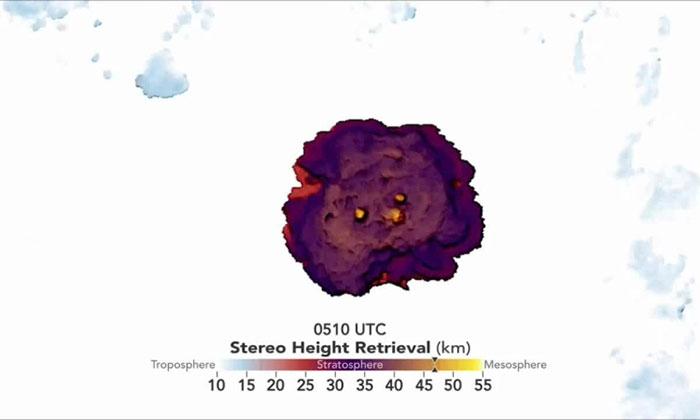The heat from the volcano combined with moisture from the ocean caused the ash plume from the Tonga volcano to reach the mid-stratosphere of the atmosphere.
Video capturing 13 hours of the Tonga volcano eruption on January 15, compiled from observations by the GOES-17 and Himawari-8 satellites. (Video: NASA Earth Observatory)
The volcanic eruption that shook the island nation of Tonga in the Pacific Ocean in January was so powerful that it sent ash plumes into the mid-stratosphere, the third and coldest layer of Earth’s atmosphere, Verge reported on February 17. Reaching heights of 58,000 meters above the Earth’s surface, this may be the highest volcanic ash plume ever recorded by satellites, according to NASA.
NASA measured this ash plume using two weather satellites GOES-17 (NASA) and Himawari-8 (Japan Aerospace Exploration Agency – JAXA) that happened to be “in the right place at the right time.” They captured still images and infrared photos, providing a detailed view of the eruption from above.
Approximately 30 minutes after the eruption, ash, water vapor, and gases from the underwater Tonga volcano surged above the sea surface, reaching the mid-stratosphere. A second phase of the eruption also approached this height, around 50,000 meters, reaching the boundary between the mid-stratosphere and the stratosphere just below.

Aerosol particles from the ash plume remained in the stratosphere for nearly a month afterward.
The explosive combination of intense heat from the volcano and moisture from the ocean helped propel the ash plume to record heights. “This is like super fuel for a major storm. The ash plume reached 2.5 times the height of any thunderstorm we have ever observed. The eruption also generated an incredible amount of lightning,” said Kristopher Bedka, an atmospheric scientist at NASA.
Aerosol particles from the ash plume remained in the stratosphere for nearly a month after the eruption and could last up to a year or more, according to atmospheric scientist Ghassan Taha at NASA’s Goddard Space Flight Center.
Material ejected from the volcano can affect local weather and global climate. However, Taha noted that it seems the Tonga ash plume does not significantly impact the climate because it contains little SO2—the volcanic gas that causes cooling effects—but has a lot of water vapor, contributing to the impressive height of the ash plume.
The eruption also triggered a powerful tsunami that swept through Tonga. The islands were isolated from other parts of the world for several days due to the disaster damaging the undersea cable that provides internet access. Currently, the recovery from the volcanic eruption and tsunami in Tonga is estimated to require about $90 million, equivalent to over 18% of the country’s GDP, according to estimates from the World Bank (WB).


















































